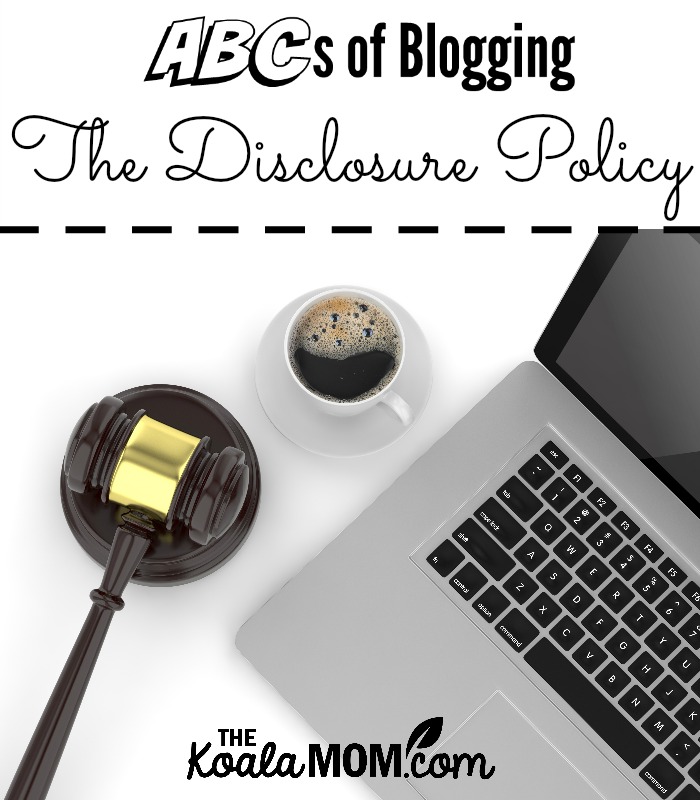Among the blog groups I belong to, there are frequent discussions around your disclosure policy. This is a bit of a grey area in blogging (especially in Canada), but the basics are that if you blog for any kind of product or payment, you should let your readers know about it. Somewhere on your blog, you need some sort of disclosure policy.
The Disclosure Policy in Canada and the US
Canada really has no laws around blogging. This means that as a Canadian blogger, I don’t have to tell my readers whether or not I’m making money off my blog. However, as a mom who is committed to transparency and honesty with my readers, that doesn’t sit right with me. I also think that sooner or later, Canada will implement laws and so I might as well be ahead of the game and include a disclosure policy now (rather than have to revise posts later).
In the United States, the Federal Trade Commission does have regulations surrounding blogging and earning money. While I’m a Canadian blogger, many of my readers are in the States, so I do read articles about the FTC rulings and try to follow their guidelines. If you are an American blogger, I strongly recommend checking out some of the articles at the end of this post and looking up the FTC requirements for your blog.
The Disclosure Policy for Amazon and Other Affiliate Links
If you use affiliate links in any of your content, you will want to look up the disclosure policy requirements. For example, I’m an Amazon affiliate. Amazon has specific requirements about the disclosure policy their affiliates use. I’ve added their exact statement to my About Me page and my Disclaimers page. I also try to add a note to every post in which I include an affiliate link, indicating that I have done so. This is supposed to go before the link, so that readers know before they click that the link is an affiliate link.
The No-Follow Tag: Google’s Disclosure Policy
The no-follow tag also comes up frequently in blog group discussions. Basically, this is Google’s disclosure policy. By including the no-follow tag on a paid or affiliate link, you are disclosing to Google’s search engine that this is a paid or affiliate link. If you don’t do this, Google will assume that you are “voting for” or recommending this site to your readers. If you’ve received any sort of compensation for this link in your post, you need to let Google (and your readers) know.
Writing Your Disclosure Policy
So exactly how do you write a disclosure policy? You can have some fun with this. Although it is a legal requirement of blogging, you can still let your personality show up (unless you are required to use exact wording by Amazon or another company). For example, blogger and entrepreneur John Chow has an absolutely amazing, hilarious disclosure policy.
I recommend including a blanket disclosure policy in your About Me page or a similar place on your blog. Some bloggers put this in their sidebar or footer. Where it goes is up to you (and the companies you work with).
You should also include a shorter, briefer disclosure policy with any sponsored post, product review, or post that contains affiliate links. I usually include it at the bottom of the post or wherever the company has specified. For example, Shopper’s Drug Mart has specific requirements for the sponsored posts I’ve written for them. Some bloggers include a link in this brief statement to their more formal policy, in case readers want to know more.
The FTC says this statement should come at the top of the post, so you know as soon as you begin reading that the post is monetized in some way. This can actually help with SEO. For example, Yoast (my SEO plugin) likes it when I include the keyword for a post in the first paragraph. Sometimes, however, I have a longer intro to write and don’t mention the keyword until further down. Then the disclosure statement can aid in SEO, like in my post about Juliano’s.
 Futher Reading:
Futher Reading:
- How to Blog Legally (includes lots of info about FTC guidelines)
- How to Install Amazon’s Required Affiliate Statement on Your Website
- What is the No-Follow Tag: When and How to Use It (infographic)


No Responses Yet